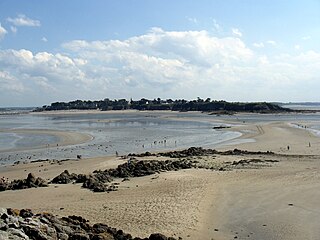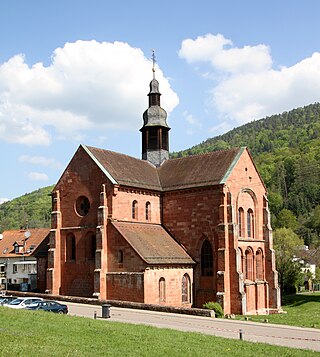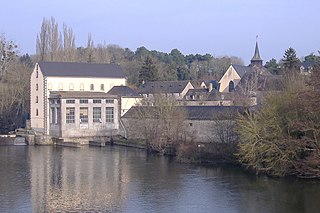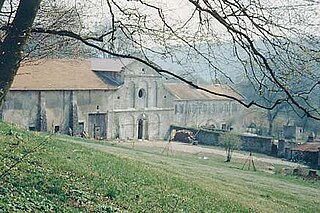
Metz is a city in northeast France located at the confluence of the Moselle and the Seille rivers. Metz is the prefecture of the Moselle department and the seat of the parliament of the Grand Est region. Located near the tripoint along the junction of France, Germany and Luxembourg, the city forms a central place of the European Greater Region and the SaarLorLux euroregion.

Morimond Abbey is a religious complex in Parnoy-en-Bassigny, Haute-Marne department, in the Champagne-Ardenne region of France. It was the fourth of the four great daughter abbeys of Cîteaux Abbey, of primary importance in the spread of the Cistercian Order, along with La Ferté to the south, Pontigny to the west and Clairvaux to the north.

Viktring Abbey is a former Cistercian monastery in the Austrian state of Carinthia. It is now a Roman Catholic parish, since 1973 a district of the Carinthian capital Klagenfurt.

La Cambre Abbey or Ter Kameren Abbey is a former Cistercian abbey in the City of Brussels, Belgium. It is located in the Maelbeek valley between the Bois de la Cambre/Ter Kamerenbos and the Ixelles Ponds. The abbey church is a Catholic parish of the Archdiocese of Mechelen–Brussels and home to a community of Norbertine canons, while other parts of the monastery house the headquarters of the Belgian National Geographic Institute (NGI) and La Cambre, a prestigious visual arts school.
The Abbey of St. Evre was a Benedictine, later Cluniac, monastery in Toul, France. Established in or just before 507, it was the oldest monastery in Lorraine and of great significance in the monastic and religious reforms in the Rhine and Moselle region of the 10th and 11th centuries.

Saint-Jacut-de-la-Mer is a commune in the Côtes-d'Armor département of Brittany in northwestern France.

Schorbach is a commune in the Moselle department of the Grand Est administrative region in north-eastern France.

Vaux-de-Cernay Abbey is a former Cistercian monastery in northern France (Île-de-France), situated in Cernay-la-Ville, in the Diocese of Versailles, Yvelines. The abbey was abandoned during the French Revolution and fell into partial ruin. Most of the buildings, except for the church, were restored in the late 19th century by Charlotte de Rothschild, and the property is now a hotel.

The Princely Abbey of Stavelot-Malmedy, also Principality of Stavelot-Malmedy, sometimes known with its German name Stablo, was an ecclesiastical principality of the Holy Roman Empire. Princely power was exercised by the Benedictine abbot of the imperial double monastery of Stavelot and Malmedy, founded in 651. Along with the Duchy of Bouillon and the Prince-Bishopric of Liège, it was one of only three principalities of the Southern Netherlands that were never part of the Spanish Netherlands, later the Austrian Netherlands, which after 1500 were assigned to the Burgundian Circle while the principalities were assigned to the Lower Rhenish Imperial Circle.

Lycée Fabert is a senior high school in Metz, Moselle department, Lorraine, France. The school, in the city centre, was the first lycée in Metz.

Redon Abbey, or Abbey of Saint-Sauveur, Redon, in Redon in the present Ille-et-Vilaine, Brittany, France, is a former Benedictine abbey founded in 832 by Saint Conwoïon, at the point where the Oust flows into the Vilaine, on the border between Neustria and Brittany.

Eusserthal Abbey was a Cistercian abbey in Eusserthal near Annweiler am Trifels in the Rhineland-Palatinate, Germany. All that now remains of it is the front portion of the abbey church, which is now used as a parish church.

The Abbey of Saint-Arnould, St. Arnold, Saint-Arnoult or Abbey of the Holy Apostles is a Benedictine abbey residing in Metz since the 6th century.

Port-du-Salut Abbey, also the Abbey of Notre-Dame du Port du Salut is a Trappist monastery located in Entrammes, Mayenne, France. The main monastery building dates from around the 13th century.

The Metz Citadel was a fort built at Metz, northeast France in the second half of the 16th century.

The Abbey of Saint-Seine is a former Benedictine monastery located in Saint-Seine-l'Abbaye, Côte-d'Or, Burgundy, France. During the Middle Ages it was a wealthy and powerful institution. It was suppressed at the French Revolution.

Hornbach Abbey is a former monastery founded around 741 in the historic town of Gamundias by Saint Pirmin, which soon became a Benedictine abbey. The most important neighbouring abbeys were Bausendorf, Saint-Avold, Glandern, Villers-Bettnach, Fraulautern, Mettlach, Tholey, and the stift of St. Arnual. The neighboring spiritual centers were Trier and Metz. At present, all that remains of Hornbach Abbey are the structural remains of the convent buildings, which have been supplemented by a monastery museum, and a modern chapel with the historical tomb of the monastery's founder.

Les Écharlis Abbey is a former Cistercian monastery in Villefranche, Yonne, France. It was founded in the 12th century by a secular priest with two companions who wanted to live a monastic life. Soon afterward, the monastery joined the Cistercian order as a dependency of Fontenay Abbey.

Sainte-Marie-au-Bois is a former abbey of the Premonstratensians order, located in the commune of Vilcey-sur-Trey, Meurthe-et-Moselle, France, built near a spring at the bottom of a small valley where a tributary of the Trey flows. Long considered the oldest settlement of the Premonstratensians order in Lorraine, its abbot in the early 17th century was Servais de Lairuelz, who led the reform of his order, first in Lorraine and then beyond. At the start of the First World War, French writer and poet Charles Péguy stayed at the former abbey, now a farm. Today, its remarkable remains make Sainte-Marie-au-Bois a rare architectural reminder of the Prémontré order in the 12th century.

The Abbey of Saint-Symphorien or St Symphorian's Abbey is a former Benedictine monastery founded by Saint Papoul, bishop of Metz, in 609. It was the first Benedictine abbey for men built in Austrasia.



















